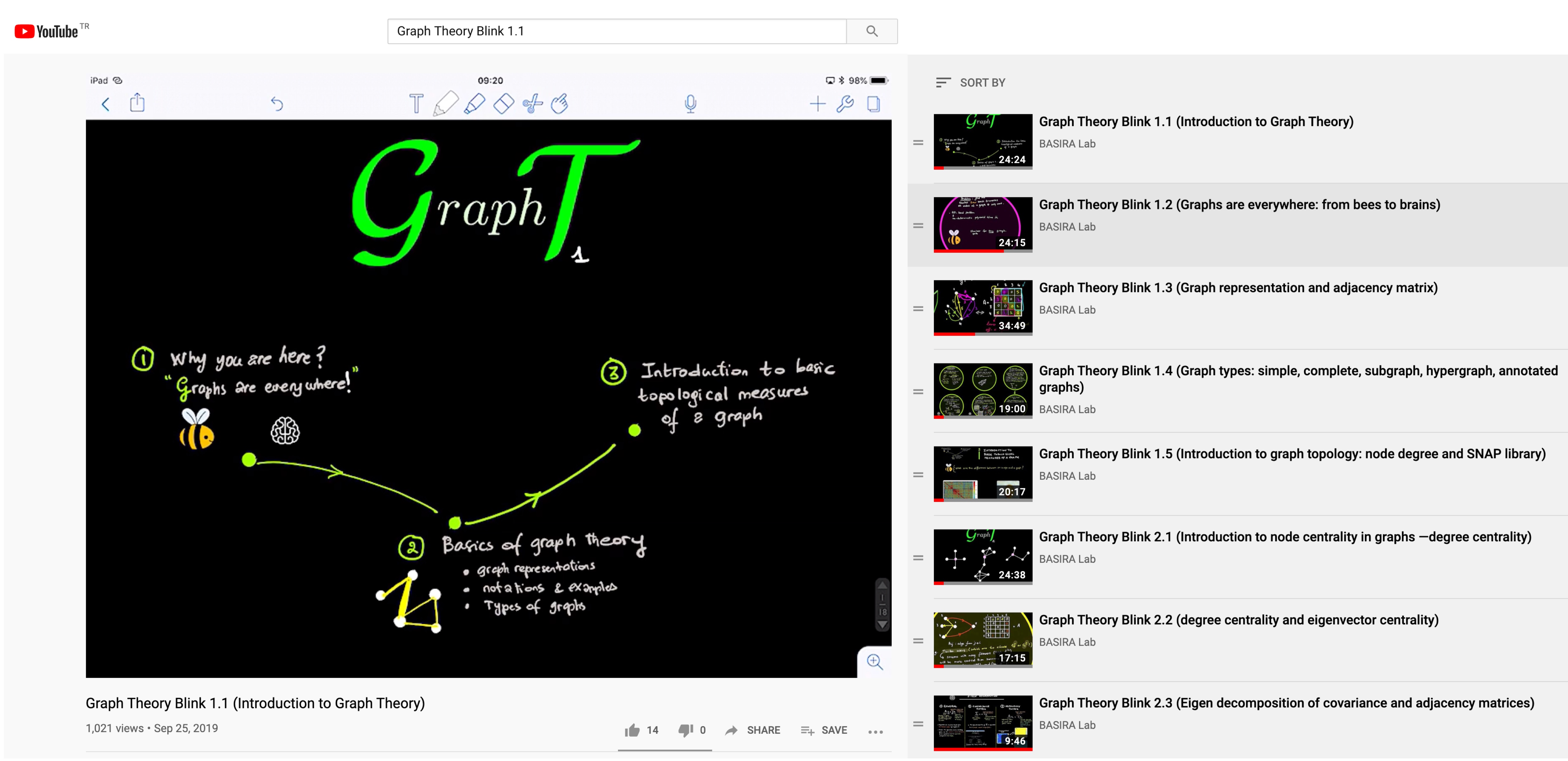MODULES
BLG-549E (Graph Theory, graduate fall 2019)
Aims. This course comes at the intersection of mathematics, learning, and algorithms. It aims to give a flavor of different aspects of the broad and ever-expanding field of graph theory and analysis.
*** Primarily textbooks:
1) Bullmore, Edward T._ Fornito, Alex_ Zalesky, Andrew – Fundamentals of Brain Network Analysis-Academic Press, Elsevier (2016)
2) Arthur Benjamin, Gary Chartrand, Ping Zhang – The Fascinating World of Graph Theory-Princeton University Press (2015)
3) (Graduate Texts in Mathematics) Reinhard Diestel – Graph theory-Springer (2006)
Link. Check Graph Theory Lecture playlist on BASIRA YouTube channel:
https://www.youtube.com/watch?v=dEGmpwPMBH0&list=PLug43ldmRSo3MV-Jgjr30E5SpwNKkjTvJ
BLG-527E (Machine Learning, graduate spring 2018-2020 course); BLG-454E (Learning from Data, undergrad spring 2018-2020 course)
Aims. The aim of this module is to provide students with an understanding of machine learning methods and their design and applications to solve real world problems.
Link. Check Machine Learning Lecture playlist on BASIRA YouTube channel:
https://www.youtube.com/watch?v=HyWmnlahXAA&list=PLug43ldmRSo1LDlvQOPzgoJ6wKnfmzimQ
AC21007 (Algorithms & Artificial Intelligence)
Aims. The aim of this module is to provide students with an understanding of methods of algorithm design, an understanding of algorithm complexity, knowledge and understanding of basic artificial intelligence tools.
Indicative content.
– Analysis of the structure of algorithms, pseudocode conventions;
– Space and Time complexity, Big-Oh notation;
– Artificial intelligence:
+ Graph/network analysis and search methods,
+ Use of SNAP C++ library (http://snap.stanford.edu) for AI program development,
+ Basics of machine-learning and neural networks in AI
Link. Check undergrad (level 2), AC21007, University of Dundee:
https://www.dundee.ac.uk/study/modules/computing/#!faq-4
AC21012 (Users and Interfaces)
Aims. The aim of this module is to teach students how to design interfaces through an interactive process with the target users using different prototyping methods. In recent years, the intersection of user interfaces and brain sciences propelled research on brain-computer interfaces (BCI). This module will lay the foundations of BCI and how it can leverage machine learning techniques to help people with disabilities or disorders.
Learning objectives.
Knowledge and understanding:
-To design and implement basic interfaces for the needs of specific user groups
-To compare and contrast qualitative design methods
-To design and evaluate a solution through user feedback
-To learn about Brain-Computer Interfaces and what they are used for
Subject-specific practical and intellectual skills and attributes:
-To evaluate user requirements from specific user groups
-To explore different methods of user interface prototyping
-To develop and evaluate different prototypes for your solution
Transferrable, employability and enterprise skills and attributes:
-To develop and apply problem-solving, communication, team-working, time-management, self-assessment and independent study skills
Link. Check undergrad (level 2) module, AC21012; University of Dundee.
Research Frontiers Module: “Data Analytics for Healthcare Technologies”
Aims. The world is awash with big and complicated data, engineers and researchers are trying to make sense out of it. Leading examples include image and behavioral data from Facebook and Google, as well as medical and healthcare data where companies such as Toshiba and Siemens compete over finding ‘the best’ solution(s) to most challenging problems in big medical data analysis. This has led to an explosion of interest in the field of machine learning, where researchers ‘engineer’ methods that learn how to efficiently analyze, represent and interpret data. In this module, we will get a foundational understanding of several compelling machine learning methods, that were applied to address healthcare questions (e.g., what distinguishes a brain with dementia from a healthy brain?). However, what is most important in this module is not just learning about ‘machine-learning’ methods with application to healthcare problems, but the following learning objectives.
Learning objectives.
Knowledge and understanding:
-Knowledge of machine learning techniques used to solve big data problems.
-Knowledge of medical problems solved using machine learning methods.
-Knowledge of Matlab tools and libraries.
Subject-specific practical and intellectual skills and attributes:
-The ability to read and understand a machine-learning paper from scratch (without any prior or advanced mathematical knowledge).
-The ability to reverse-engineer a machine-learning code in C++/Matlab. This will be based on the ‘3-Bs strategy’: Breaking, Blending, and Bending.
-The ability to take your understanding of the code one step further through suggesting more creative solutions.
Transferrable, employability and enterprise skills and attributes:
-The ability to crack the components of a solution to a specific problem.
-The ability to come up with multiple creative solutions to the different problems.
-Learning how to prepare compelling and clear presentations.
Link. Check MSc and undergrad (level 4) modules: AC24001, AC42002, AC52008, and AC52044; University of Dundee.


